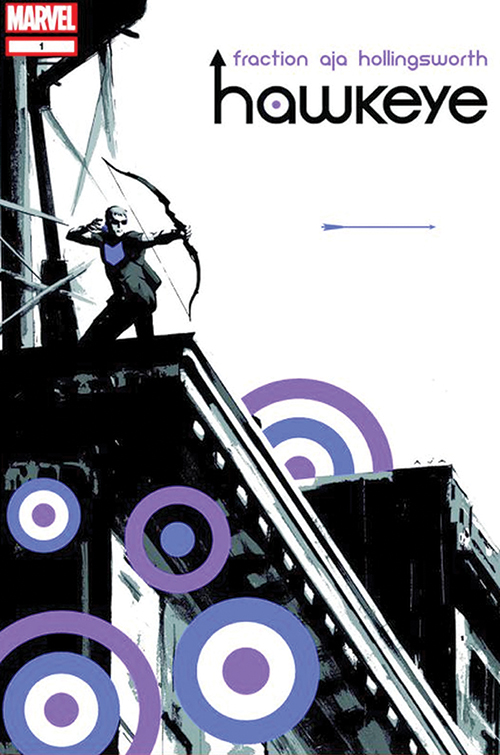Most people came out of last year’s megahit superhero flick The Avengers with a favorite character. Iron Man remains pretty popular thanks to Robert Downey Jr., and the Hulk certainly gained a few new fans with his show-stopping scenes.
Hitting the mark

Most people came out of last year’s megahit superhero flick The Avengers with a favorite character. Iron Man remains pretty popular thanks to Robert Downey Jr., and the Hulk certainly gained a few new fans with his show-stopping scenes.
But let’s face it: Hawkeye is nobody’s favorite.
For every cape that’s had a less-than-stellar representation at the Cineplex, you can find the original material that made some Hollywood producer think the character could work on the big screen given the right approach.
Movie duds like Green Lantern, Daredevil, Ghost Rider and Catwoman all failed despite great interpretations that already existed on the printed page.
Matt Fraction and David Aja’s recent comic book relaunch of Marvel’s Hawkeye not only proves that the indigo archer isn’t inherently lame, it also acts as a great example of the medium’s capabilities.
Though a few recognizable Avengers make brief appearances, Hawkeye: My Life as a Weapon mostly centers on the street-level adventures of its titular hero, real name Clint Barton.
The series has been described as “what Hawkeye does when he’s not being an Avenger.” We spend a lot of time in his Brooklyn apartment complex, where Clint lives next to several affable neighbors who are very casual about his not-so-secret-identity.
This grounded approach fits well with the character, who has no real superpowers to speak of other than being an ace with a bow and arrow. Gone are the garish costumes and masks—Clint’s never seen in anything other than “normal people” clothes, often purple.
The initial villains are small-time, too. A group of ambiguously Eastern European mobsters happen to own the building that Clint and his friends live in, and they aren’t too shy about jacking up rent or threatening violence while using the word “bro” a lot.
Though it sounds like a safe, even bland set-up for a rote procedural, Hawkeye’s presentation is remarkably stylish.
The first thing most readers will notice is the stark, black line that artist Aja uses across every page. From a crowded rooftop party to a close-up of a crooked smile, details are left intentionally sparse; more than most comics, Hawkeye’s visuals are part illustration and part design.
Matt Hollingsworth’s muted coloring accents the world without distracting from it. Unlike most superhero comics, which are heavy with fancy lighting and airbrush techniques, Hawkeye is colored flat with no embellishments.
It’s like the world’s foremost Microsoft Paint expert used the bucket fill-in tool to paint by numbers. The result is striking, at times arresting, and it’s like no other comic you’ve seen before.
This volume is split into five chapters, each its own self-contained tale, with chapters four and five being a two-parter. Aja tags in Javier Pulido for that story, which sees Hawkeye and his female teenage sidekick (also named Hawkeye—long story) jetting off to crash a supervillain auction house.
Pulido’s art is more detailed and expressive, and he can draw the heck out of a fight scene, but his work lacks Aja’s unique, vibrant punch. Hawkeye retains a visual continuity, however, thanks in part to Hollingsworth’s consistent colors.
It seems odd to mention the writing almost as an afterthought, but Portland native Matt
Fraction makes it look too easy. Each of the chapters in My Life as a Weapon were originally released as single-issue floppies, and they all seem written with Stan Lee’s sage wisdom in mind: “Every comic book is someone’s first comic book.”
The sharp pacing, snappy dialogue and the satisfying conclusions in each chapter make this one of the most accessible graphic novels a comics virgin could read.
Especially impressive is how Fraction is able to play with time without confusing the reader. Typically, a story starts with a bad situation and we rewind backward to find out how said sticky wicket came about. This technique is popular in film and especially recent television, but Fraction employs it effortlessly.
What might be the standout story of the bunch depicts Hawkeye right in the middle of a ’70s-style car chase, with occasional flashbacks that eventually explain why Clint is scrambling to use all of his goofy trick arrows.
The scene is plotted in such a way that it’s always clear what is happening when and how, but it doesn’t condescend to the audience—there are no giant block letters telling you that it’s “three hours earlier” or “28 minutes later.”
The art, setting and dialogue all communicate that information, making for seamless transitions that are invaluable for an exciting and well-paced story.
Hawkeye: My Life as a Weapon comes recommended not only for superhero fans, not only for comics readers, but for anyone who’s open enough to read great stories told in a way they haven’t seen before.





